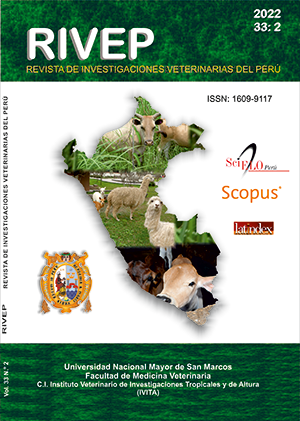End-to-end jejunal anastomosis lined with mesenteric flap in horses
DOI:
https://doi.org/10.15381/rivep.v33i2.22580Keywords:
anastomosis, mesenteric flap, equine, jejunum, surgeryAbstract
Postoperative complications after intestinal anastomosis remain the main concern in abdominal surgery in horses. The aim of this study was to describe an end-to-end jejunal anastomosis with a mesenteric flap covering technique and its macroscopic and postoperative histological characteristics. This technique is based on a reinforcement to the conventional surgery performed with a simple interrupted suture pattern to prevent postoperative complications. Five previously premedicated horses with xylazine 0.5 mg/kg, acepromazine 0.03 mg/kg and tramadol 2 mg/kg were induced to general anesthesia with diazepam 0.25 mg/kg and ketamine 2.2 mg/kg. General anesthesia was maintained with a minimum alveolar concentration of 1.4 ± 0.2% of isoflurane. A midline abdominal wall approach was made. A 10 cm jejunal segment was selected for resection and end-to-end anastomosis. A mesenteric flap large enough and proportional to the perimeter of the suture line was cut to cover the anastomotic area, fixing it to the intestinal serosa with a simple non-perforating discontinuous suture. Two animals underwent relaparotomy on the 7th and 30th postoperative days to describe the macroscopic and histopathological characteristics of the anastomotic area. In the macroscopic evaluation, no adhesions were observed and the mesenteric lined was well adhered to the anastomotic line, without contraction or displacement. Histopathological findings evidenced a healing process and adaptation of the mesenteric flap to loose connective tissue, which included fibrocytes, collagen, and slight edema. This technique turned out to be effective and could be useful in cases where equine intestinal resection anastomosis is necessary.
Downloads
Downloads
Published
Issue
Section
License
Copyright (c) 2022 Alfredo Delgado C., César M. Gavidia, Cristina García B., Jierson Mendoza E., Jeam J. Ampuero C., Zaida Aguinaga S., Eduardo Giron G., Alfonso Chavera C., Ceesar N. Aguilar G.

This work is licensed under a Creative Commons Attribution 4.0 International License.
AUTHORS RETAIN THEIR RIGHTS:
a. Authors retain their trade mark rights and patent, and also on any process or procedure described in the article.
b. Authors retain their right to share, copy, distribute, perform and publicly communicate their article (eg, to place their article in an institutional repository or publish it in a book), with an acknowledgment of its initial publication in the Revista de Investigaciones Veterinarias del Perú (RIVEP).
c. Authors retain theirs right to make a subsequent publication of their work, to use the article or any part thereof (eg a compilation of his papers, lecture notes, thesis, or a book), always indicating the source of publication (the originator of the work, journal, volume, number and date).










